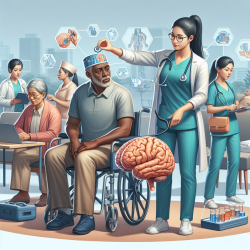Introduction
In the realm of public health, the intersection of homelessness and traumatic brain injury (TBI) presents a unique challenge. The scoping review titled "Rehabilitation among individuals experiencing homelessness and traumatic brain injury: A scoping review" sheds light on this critical issue. The review explores the extent to which rehabilitation services are available to, or utilized by, individuals experiencing both homelessness and TBI. The findings highlight significant gaps and opportunities for healthcare practitioners to improve outcomes for this vulnerable population.
The Prevalence of TBI Among the Homeless
Traumatic brain injury is disproportionately prevalent among individuals experiencing homelessness. A systematic review estimated that the lifetime prevalence of TBI among homeless individuals is a staggering 53.1%. This high prevalence is concerning, given the bidirectional relationship between TBI and homelessness, where each condition exacerbates the other.
Key Findings from the Scoping Review
The review identified 15 peer-reviewed articles and three gray literature reports that describe interventions for individuals experiencing homelessness and TBI. Despite the existence of rehabilitation programs, the review found that many interventions do not specifically address TBI, even though a high proportion of participants have a history of TBI.
Key opportunities for adaptation include:
- Screening for TBI: Identifying TBI in clients is crucial for tailoring interventions to address specific impairments.
- Cognitive and Functional Assessments: Conducting these assessments post-screening can provide insights into how cognitive limitations impact daily functioning.
- Tailoring Interventions: Multidisciplinary teams can tailor interventions to accommodate TBI-related impairments, enhancing the effectiveness of rehabilitation.
Education and Training for Healthcare Providers
The review emphasizes the need for structured education and training for healthcare professionals working with this population. Such training should focus on TBI screening, functional assessments, and the development of strategies to manage TBI-related impairments. Collaboration with multidisciplinary teams and co-development of educational materials with service users are recommended to enhance understanding and service delivery.
Recommendations for Future Research
There is an urgent need for research that considers the diverse rehabilitation needs of individuals experiencing homelessness and TBI. Future studies should adopt an intersectional lens to address the unique challenges faced by individuals with intersecting identities, such as race, gender, and disability. Additionally, examining equity considerations in clinical practice guidelines for TBI and homelessness could provide a foundation for advancing rehabilitation care for this population.
Conclusion
The scoping review provides a foundation for improving rehabilitation services for individuals experiencing homelessness and TBI. By integrating TBI screening, cognitive assessments, and tailored interventions within a multidisciplinary framework, healthcare providers can enhance the effectiveness of rehabilitation programs. Furthermore, education and training initiatives are crucial for equipping providers with the necessary tools and knowledge to support this vulnerable population effectively.
To read the original research paper, please follow this link: Rehabilitation among individuals experiencing homelessness and traumatic brain injury: A scoping review.










